In Burgundy (2)
Labels: Burgundy
mainly wine...
Labels: Burgundy
Labels: Burgundy, restaurants
Excited to be off to Burgundy for a short trip tomorrow morning. Some nice visits planned:
Labels: Burgundy
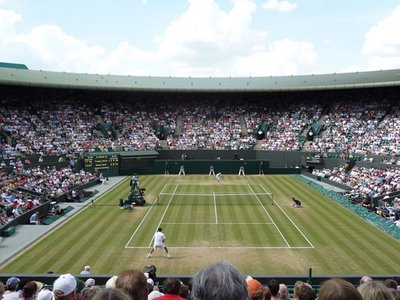 A quick blog post before I retire to bed, tired from a busy day.
A quick blog post before I retire to bed, tired from a busy day.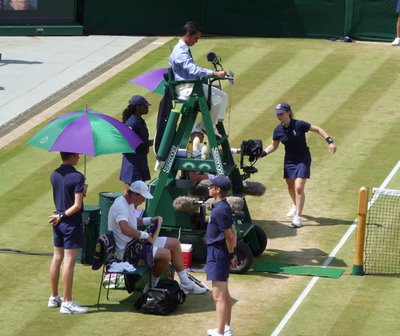 We took the train from Strawberry Hill and walked up from Wimbledon station, through pretty Wimbledon village. Fiona used to live round here, and it's a really attractive area.
We took the train from Strawberry Hill and walked up from Wimbledon station, through pretty Wimbledon village. Fiona used to live round here, and it's a really attractive area. 
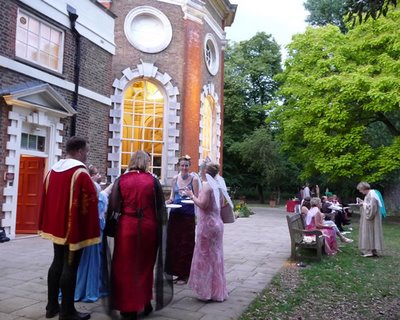
No work today at all. Spent the day playing cricket for the wine trade XI versus the Hampshire Hogs down in Warnford.
Labels: cricket
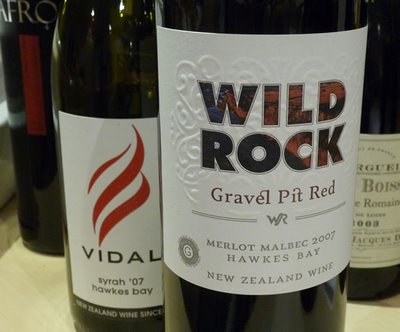 Tonight's drinking: two red wines, both from the same remarkable patch of land. That'll be New Zealand's Hawkes Bay region, and more specifically the Gimblett Gravels - a relatively recently discovered terroir that makes lovely red wines, both from Syrah and also Bordeaux varieties. These wines aren't the very best that the Gimblett has to offer (Waitrose have a couple of Craggy Range wines - Block 14 and Sophia - that should give you that), but they are affordable and delicious.
Tonight's drinking: two red wines, both from the same remarkable patch of land. That'll be New Zealand's Hawkes Bay region, and more specifically the Gimblett Gravels - a relatively recently discovered terroir that makes lovely red wines, both from Syrah and also Bordeaux varieties. These wines aren't the very best that the Gimblett has to offer (Waitrose have a couple of Craggy Range wines - Block 14 and Sophia - that should give you that), but they are affordable and delicious.Labels: New Zealand, syrah
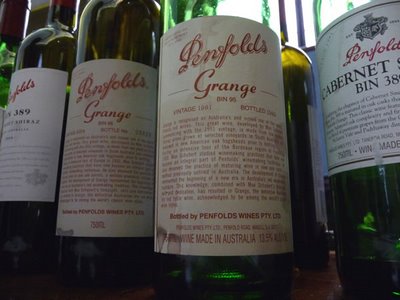 Very interesting tasting this afternoon. It was held at Australia House (where they have the annoying rule that if the invitation says 3.30 pm, you aren't even allowed in the building until 3.30 pm), and it involved a vertical of two Penfolds wines: the iconic Grange, and its sibling the Bin 389. There was a good turnout, including cricketing legend Ian Botham.
Very interesting tasting this afternoon. It was held at Australia House (where they have the annoying rule that if the invitation says 3.30 pm, you aren't even allowed in the building until 3.30 pm), and it involved a vertical of two Penfolds wines: the iconic Grange, and its sibling the Bin 389. There was a good turnout, including cricketing legend Ian Botham.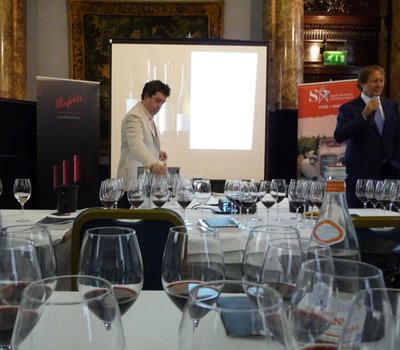
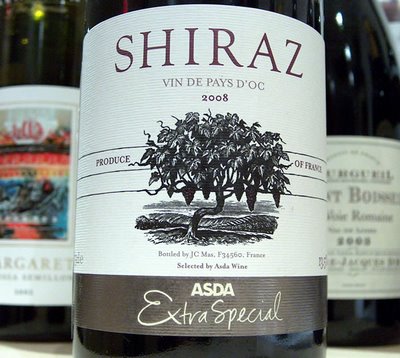
I'm drinking Riesling tonight, sitting outside just after the light has finally faded and the temperature has dipped into the late teens.
Labels: New Zealand, Riesling
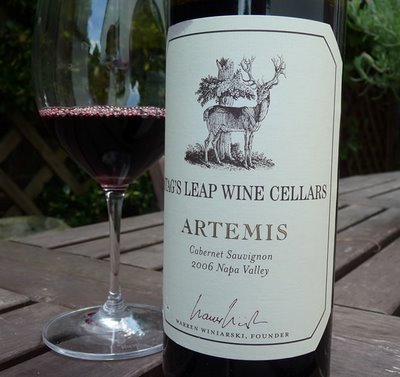 Where can you find world-class Cabernet Sauvignon-based wines outside Bordeaux? Australia does a good job in Margaret River and Coonawarra (and I'd add Clare Valley, too), but perhaps the leading contender is California's Napa Valley, where the leading wines compete in price with the very best from Bordeaux.
Where can you find world-class Cabernet Sauvignon-based wines outside Bordeaux? Australia does a good job in Margaret River and Coonawarra (and I'd add Clare Valley, too), but perhaps the leading contender is California's Napa Valley, where the leading wines compete in price with the very best from Bordeaux.Labels: Cabernet Sauvignon, california, napa
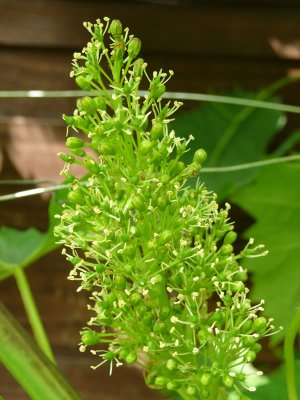
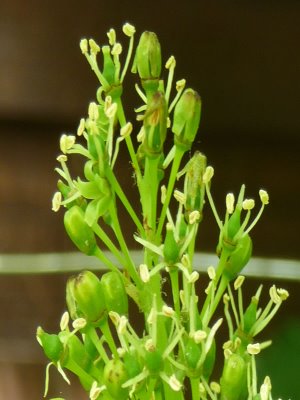
Labels: viticulture
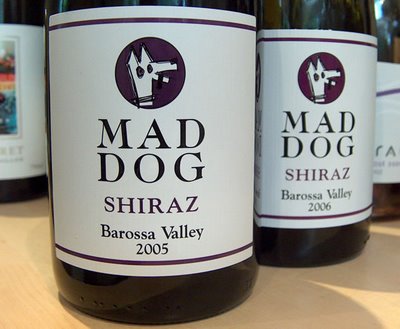 Fellow blogger and Barossa grape grower Matthew Munzberg recently sent me two vintages of his own wine to try. It's a Shiraz called 'Mad Dog', and is brilliantly packaged. I like the wines a lot: typical Barossa style, with lots of character. Matthew makes 400 cases from the best of his 35 hectares of vineyards in the heart of the Barossa, and the wine is available in the UK from Corney & Barrow (here) for £15.99 a bottle.
Fellow blogger and Barossa grape grower Matthew Munzberg recently sent me two vintages of his own wine to try. It's a Shiraz called 'Mad Dog', and is brilliantly packaged. I like the wines a lot: typical Barossa style, with lots of character. Matthew makes 400 cases from the best of his 35 hectares of vineyards in the heart of the Barossa, and the wine is available in the UK from Corney & Barrow (here) for £15.99 a bottle.
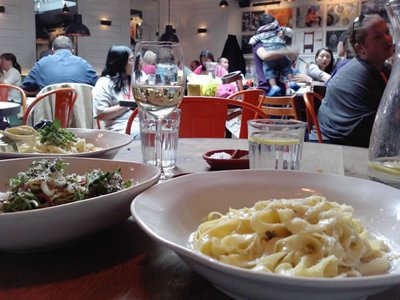 Fiona and I headed off to Kingston for lunch today. We checked out Jamie's Italian (www.jamieoliver.com/italian), one of the restaurants in the neighbourhood Italian chain that Jamie Oliver is in the process of building.
Fiona and I headed off to Kingston for lunch today. We checked out Jamie's Italian (www.jamieoliver.com/italian), one of the restaurants in the neighbourhood Italian chain that Jamie Oliver is in the process of building.Labels: Italy, restaurants
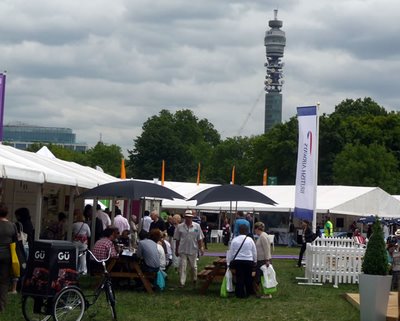 Had a reasonably busy day today. I began by meeting with Aussie wine scientist Richard Gibson, who runs a wine consultancy called Scorpex (http://www.scorpex.net/). We discussed closures, and oxygen and wine.
Had a reasonably busy day today. I began by meeting with Aussie wine scientist Richard Gibson, who runs a wine consultancy called Scorpex (http://www.scorpex.net/). We discussed closures, and oxygen and wine.
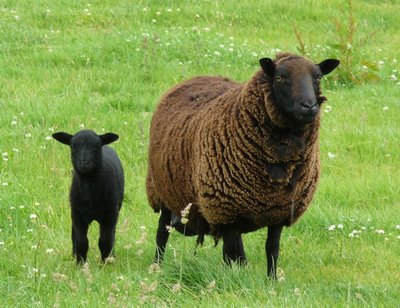 We took advantage of our child-free status to walk in the countryside. The walk? One of the Guardian's series on British walks, this one in the Oxfordshire countryside focusing on the white horse of Uffington - here. It was really enjoyable, and the directions were clear and unambiguous. We completed the 10 mile route in 3.5 hours, and for most of the way RTL could be let off the lead.
We took advantage of our child-free status to walk in the countryside. The walk? One of the Guardian's series on British walks, this one in the Oxfordshire countryside focusing on the white horse of Uffington - here. It was really enjoyable, and the directions were clear and unambiguous. We completed the 10 mile route in 3.5 hours, and for most of the way RTL could be let off the lead. 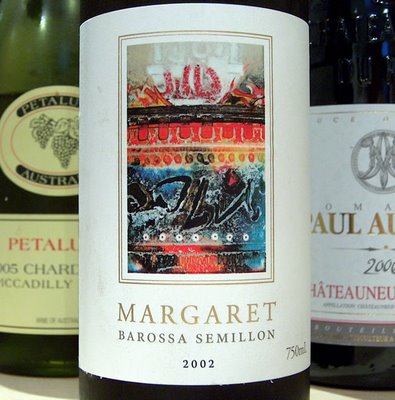 Tonight's wine? An Australian Semillon, but not from the Hunter Valley. Hunter Semillons are one of Australia's unique contributions to the fine wine scene: they're low in alcohol, high in acidity, and start out life neutral but age into a beautiful toasty maturity. Now this is an exception. It's a top Semillon but it comes from the Barossa.
Tonight's wine? An Australian Semillon, but not from the Hunter Valley. Hunter Semillons are one of Australia's unique contributions to the fine wine scene: they're low in alcohol, high in acidity, and start out life neutral but age into a beautiful toasty maturity. Now this is an exception. It's a top Semillon but it comes from the Barossa.There's a wonderful piece by Victoria Moore on Terroirs, the natural wine bar that's shaking the London dining scene, on the Caves de Pyrene website. This originally appeared in the ES Magazine, but it deserves a wider readership, which is why I'm plugging it here.
Labels: natural wine
The World of Fine Wine issue 24 arrived on my doormat today. It's an expensive publication (£30/$60/E50 for a single issue), but it's unbelievably rich in content (disclaimer: I write for it).
Labels: Portugal
Labels: austria, gruner veltliner
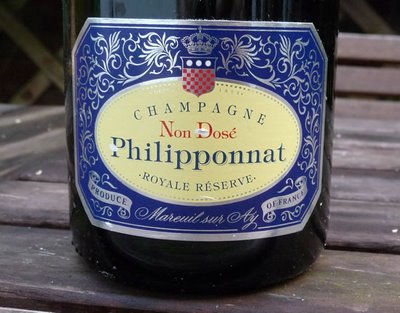 Fiona and I have a few days without children. This is almost an impossible luxury, and we were planning to go away for a few days somewhere exotic. But RTL is in season, and there's nowhere we can leave her, so we're staying put. The only solution is to drink wine, good wine, and in quantity. We made a good stab at it this lunchtime, beginning with a zero dosage Champagne in the glorious sunshine.
Fiona and I have a few days without children. This is almost an impossible luxury, and we were planning to go away for a few days somewhere exotic. But RTL is in season, and there's nowhere we can leave her, so we're staying put. The only solution is to drink wine, good wine, and in quantity. We made a good stab at it this lunchtime, beginning with a zero dosage Champagne in the glorious sunshine.Labels: Champagne
Vin Santo is a sweet wine from Tuscany that's made by picking grapes and then drying them for a while to concentrated the sweetness and acidity. These are then fermented and aged in small barrels, sealed with wax. Here's a short film made during my Chianti Classico trip of Vin Santo production at Castello della Paneretta:
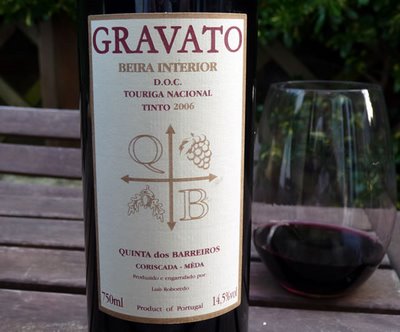 Almost a year ago I visited the Dao and Bairrada regions of Portugal; on that trip, Ana Sofia of Viniportugal encouraged me also to visit the Beria Interior, the region that is sandwiched between the Douro and the Alentejo in the east of Portugal. I'm glad she did, because this is a rather poorly known region that's making some great wines. Tonight's wine comes from here.
Almost a year ago I visited the Dao and Bairrada regions of Portugal; on that trip, Ana Sofia of Viniportugal encouraged me also to visit the Beria Interior, the region that is sandwiched between the Douro and the Alentejo in the east of Portugal. I'm glad she did, because this is a rather poorly known region that's making some great wines. Tonight's wine comes from here.Labels: Portugal, RTL, touriga nacional
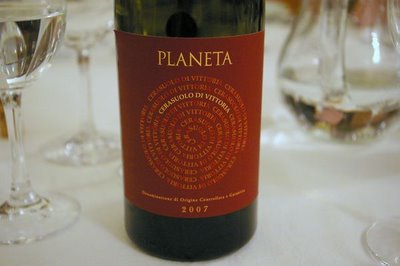 Italian restaurant chain Carluccio's (www.carluccios.com) are having a wine festival. It began a few days ago and runs through to the beginning of August, and features Sicilian wines from Planeta and the Settesoli co-op. These wines are really good, and they're exceptionally well priced, and so I thought I'd draw my readers' attention to it (no commercial link). There are free tastings of these wines every Thursday, as well as a series of special dinners.
Italian restaurant chain Carluccio's (www.carluccios.com) are having a wine festival. It began a few days ago and runs through to the beginning of August, and features Sicilian wines from Planeta and the Settesoli co-op. These wines are really good, and they're exceptionally well priced, and so I thought I'd draw my readers' attention to it (no commercial link). There are free tastings of these wines every Thursday, as well as a series of special dinners.Labels: Italy, restaurants, sicily
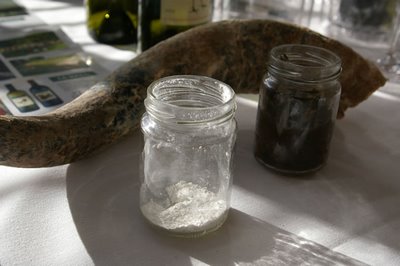 A leading expert on biodynamics kindly agreed to answer some queries I had about this unusual but increasingly important way of growing wine grapes. Here are the 12 questions I sent him. Have you got any you'd like to add to the list?
A leading expert on biodynamics kindly agreed to answer some queries I had about this unusual but increasingly important way of growing wine grapes. Here are the 12 questions I sent him. Have you got any you'd like to add to the list?
Labels: biodynamics, viticulture
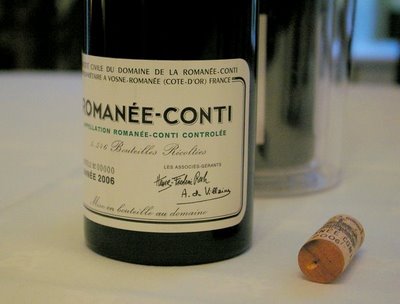 I've recently had the chance to taste some rather grand French wines blind, without realizing what I was tasting. There were some smart wines in the London installment of the Berlin tasting - Lafite, Latour and Margaux 2005. And then in the Pinot Noir session at the Landmark Australia Tutorial, Tom Carson slipped in a bottle of DRC Romanee St Vivant 2002 as a ringer.
I've recently had the chance to taste some rather grand French wines blind, without realizing what I was tasting. There were some smart wines in the London installment of the Berlin tasting - Lafite, Latour and Margaux 2005. And then in the Pinot Noir session at the Landmark Australia Tutorial, Tom Carson slipped in a bottle of DRC Romanee St Vivant 2002 as a ringer.Labels: blind tasting, perception. psychology
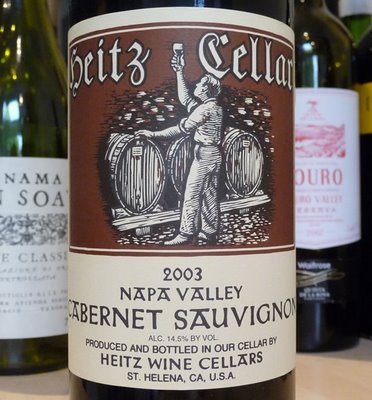 Almost as if to prove that this hasn't become Jamie's Australian Wine Blog, I'm switching my attention to a Californian wine tonight.
Almost as if to prove that this hasn't become Jamie's Australian Wine Blog, I'm switching my attention to a Californian wine tonight. Labels: california, napa
Labels: Australia, hunter valley
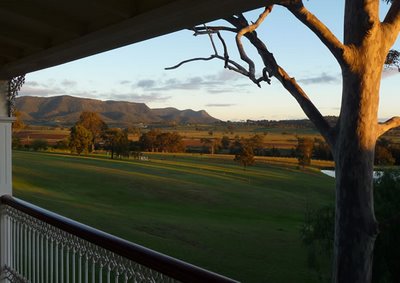 Just woken up for my last day in Australia. I'm in the Hunter, and this is the view from my room at the Sebel Kirkton.
Just woken up for my last day in Australia. I'm in the Hunter, and this is the view from my room at the Sebel Kirkton. 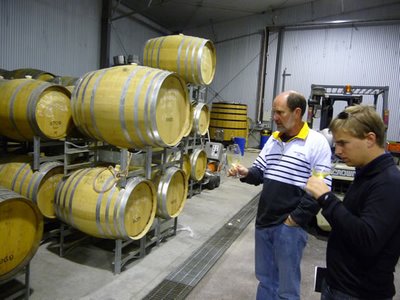
Labels: Australia, hunter valley
Labels: Australia, fortifieds
Labels: Australia, biodynamics
Just wanted to draw the attention of UK-based readers to a week-only 25% off all wine at Waitrose Wine Direct (http://www.waitrosewine.com/). Waitrose have a good range, and this is a genuinely good, honest offer.
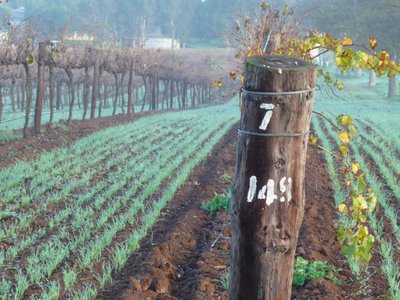 It's another beautiful morning here in the Barossa as we prepare for day 3 of the Landmark Tutorial. This morning: Iain Riggs on Semillon (and blends thereof), then Rob Mann on Cabernet (and blends thereof).
It's another beautiful morning here in the Barossa as we prepare for day 3 of the Landmark Tutorial. This morning: Iain Riggs on Semillon (and blends thereof), then Rob Mann on Cabernet (and blends thereof).
Labels: Australia
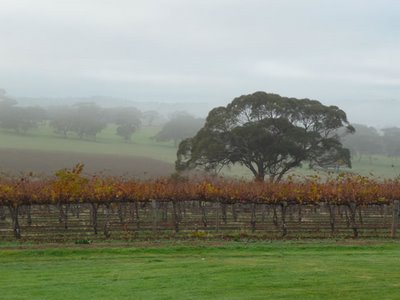 Here's the view from my room this morning here in the Barossa, as I prepare for an exciting day's tasting and learning. We are so, so lucky to be experiencing this! I hope you'll forgive my unbridled enthusiasm...
Here's the view from my room this morning here in the Barossa, as I prepare for an exciting day's tasting and learning. We are so, so lucky to be experiencing this! I hope you'll forgive my unbridled enthusiasm...
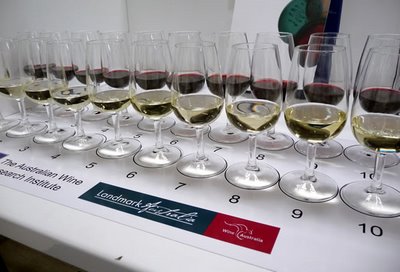 I’m now in the Barossa, staying at The Louise (www.thelouise.com.au; one of the best places I've ever stayed), and about two-thirds through day one of the Landmark Tutorial. It is already very exciting, and we’ve only really just got going.
I’m now in the Barossa, staying at The Louise (www.thelouise.com.au; one of the best places I've ever stayed), and about two-thirds through day one of the Landmark Tutorial. It is already very exciting, and we’ve only really just got going.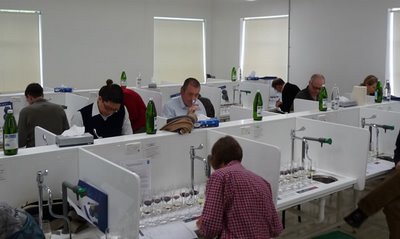 We finished late morning, and headed off to the Barossa, where, after a light lunch, we began session 1 of the Tutorial. Led by Michael Hill Smith, Andrew Caillard and Tony Jordan, it was a look at Australia’s ‘regional classics’. The tasting component consisted of some very smart wines, but even better is yet to come. With dinner - which I have a feeling will be very special - we’ll be looking at ‘Australia’s Fine Wine’.
We finished late morning, and headed off to the Barossa, where, after a light lunch, we began session 1 of the Tutorial. Led by Michael Hill Smith, Andrew Caillard and Tony Jordan, it was a look at Australia’s ‘regional classics’. The tasting component consisted of some very smart wines, but even better is yet to come. With dinner - which I have a feeling will be very special - we’ll be looking at ‘Australia’s Fine Wine’.